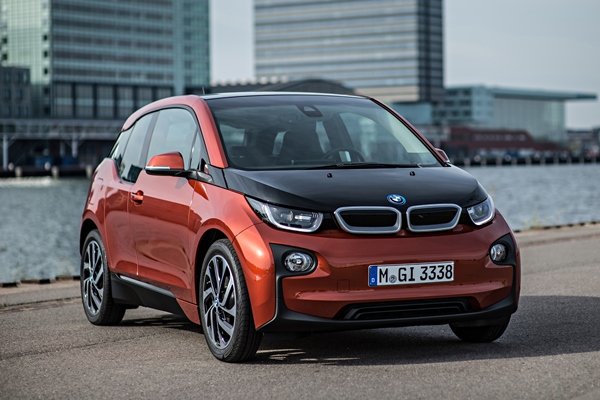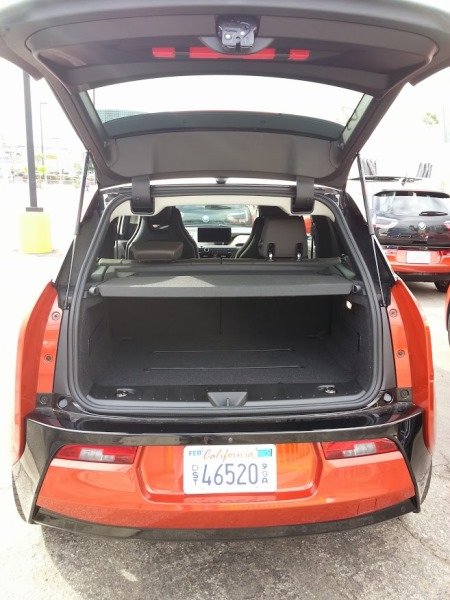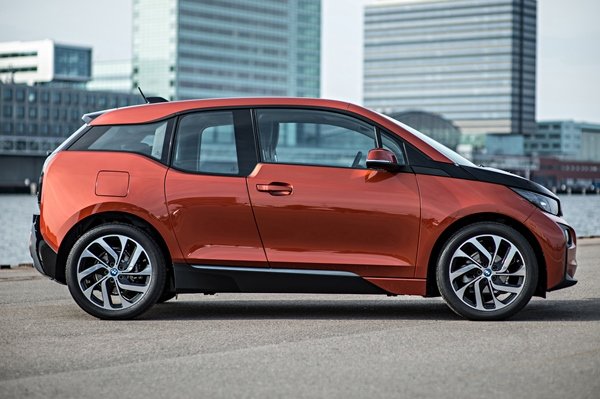
Perhaps the model for the EV of the future
And people call the LEAF ugly? To call the BMW i3’s looks different is to be kind. With its extremely short snout and bizarre rear door window design BMW is boldly inviting critical commentary. They found it here. And that’s just the front and the side. Their “black band” as they call it, wraps from the hood over the roof and down the rear hatch where it seemingly leaks past the bumper at the corners of the car. Fortunately, this is mostly where the critical part stops. If one can work past the looks and actually get inside to drive, an amazingly positive overall experience is to be found.

Before we continue, one other exterior aspect that took awhile to get beyond is tire size. One does not expect to see a modern car with 155 millimeter (mm) section width tires – especially one from a maker with a performance heritage. Granted the i3 moves up to 175 mm section width tires in back, but even the lowly Chevrolet Spark offers 185 mm tires, and those are at all four corners. The Spark, though, puts those tires around 15 inch wheels. When wrapped around the optional 20 inch wheels (below – 19s are standard), they look more like wagon wheels than suitable modern day vehicle support. But they do their job surprisingly well. The narrow tires are to reduce rolling resistance and increase the range of BMW’s electric vehicle (EV).

As any EV veteran knows, one of the first questions asked is “How far will it go?” In pure battery electric vehicle mode, BMW specifies a range of 80 to 100 miles (likely learning from Nissan not to put a hard number out there). Power is provided by a 22 kilowatt hour battery pack weighing in at 450 pounds. The electric motor is rated at 170 horsepower and 184 ft-lbs of torque. We’ll have to wait to see what the EPA has to say as the i3 won’t be available here until sometime next year. Doubling the range though, is what BMW refers to as the Range Extender model for an additional $3,850. Much less expensive and much lighter than doubling the battery capacity, BMW’s solution is a 650cc engine that adds about 330 pounds, but more importantly extends that all important range quickly and easily. More on that later.
Driving Impressions
We had the opportunity to test drive the BMW i3 on our own, but the test drive was essentially a long rectangle near the Los Angeles Convention Center. No twisty bits to have fun in. No inclines or declines. Just boring city surface streets. But we did have plenty of opportunities to evaluate the acceleration with the areas multitude of traffic lights. And the acceleration was plenty fun. BMW does a good job of making the power available as it’s needed, but not before. Putting all 184 lb-ft of torque to the skinny tires at startup would just spin them and result in little forward motion. So BMW doles out the power in the proper amount, increasing it quickly as speed gains. Think of it as incredibly important traction control. We had driven the Toyota RAV4 EV earlier in the day, and that seems to be a lesson that Toyota still has to learn. With modern day electronics what they are, there’s no reason for chattering tires when launching aggressively – EV or otherwise (although this particular trick is easier to solve with an electric motor than a gasoline engine).
The i3 offers the driver three drive modes – Comfort, ECO PRO, and ECO PRO+. As you can imagine, you get increasing levels of brake regen as you move up the progression. But BMW also starts taking away creature comforts, in the way of reduced climate control, as you opt for more range. Your top speed is also limited to 60 miles per hour should you choose to maximize your range. Drive mode is driver selectable with a small switch on the center console. As we have found driving our 2013 LEAF, we use the Brake Mode typically around town to minimize brake use when coming to stop lights or stop signs. It’s similar to downshifting a manual transmission to use engine braking. The advantage with an EV is that it provides a touch more range than the standard drive mode in addition to saving on brake wear. We anticipate that driving the i3, we would use Comfort mode, and click it into ECO PRO or ECO PRO+ as needed, then pop it back into Comfort. It doesn’t seem as easy to do in the i3 though as it is in the LEAF. The brake regen is mild in Comfort mode, moderate in ECO PRO, and aggressive in ECO PRO+. Not nearly as aggressive as the MINI E was (thank goodness), but it might actually be too aggressive for some.
Stop light to stop light acceleration is impressive in any mode. When depressed fully, the throttle provides full power in all three modes. Comfort mode provides the expected linear throttle response, with progressively less responsiveness through mid-throttle for the other two modes. Nissan does the same thing with LEAF to encourage economy by requiring a harder press on the pedal to get the same acceleration in its ECO mode. We don’t really know that it has the intended effect, although for some it might. Without any bends to evaluate handling, we had to create our own, swerving about the downtown streets of LA. Turn in is BMW crisp, with little body roll – both to be expected. We don’t expect ultimate grip to be on par with a gasoline 3 series with these skinny tires, but then again – two cars, two purposes. Surprisingly, the ride quality is amazingly good despite the odd tire size.
Back to the Range Extender, or REX. The optional onboard 34 horsepower, 650cc, two-cylinder engine is optimized to maintain the battery charge, not power the vehicle. We had the opportunity to speak with Product Engineer John Kelly about the REX. Having driven one for a couple months now, he states that due to the design parameters of the system, noise, vibration and harshness (NVH) are minimized. Having driven the Toyota Prius Plug-In Hybrid earlier in the day, we must say that Toyota did not optimize NVH considerations in that car. Granted, they are for different markets, but no one likes a noisy, shaky car. Mr. Kelly offered another observation – one that many might not immediately consider. With the REX, one could drive the i3 all day just by stopping for gas every couple hundred miles or so. And those stops would be short, because the fuel capacity is a miniscule 2.4 gallons. Certainly, that is not the intent of an electric vehicle, but for those rare trips requiring more range than what the battery alone offers, it makes the i3 a possibility for a one car household. Doubling the range to 160 to 200 miles with just over 2 gallons of gas would be the equivalent of about 75 to 80 miles per gallon, perhaps more. While Chevrolet markets the Volt as an extended range electric car, the BMW i3 actually fills the bill.
The Interior
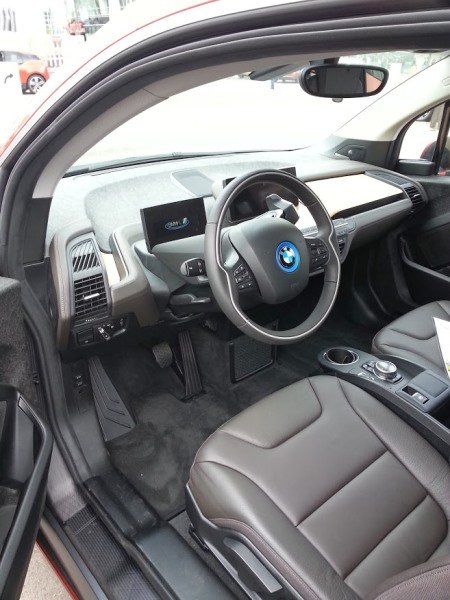
Comfortable seats greet the driver and passenger in front – less so in the rear. The interior is minimalist in some ways, as the unfinished Carbon Fiber Reinforced Plastic (CFRP) shell is visible on all of the exposed interior panels. Many will appreciate this look. Others will wonder why. The wood dashboard is attractive and will likely find many supporters. The shift mechanism is just strange. BMW sticks a stalk between the right side of the steering wheel and the dash with a large paddle on it that rotates to provide gear selection (drive or reverse). The primary display in front of the steering wheel is not very large and is partially obstructed by the wheel. Rear cargo area is limited as the electric motor sits underneath and drives the rear wheels. There is a front cargo space that is slightly larger than a one gallon milk container below the hood.
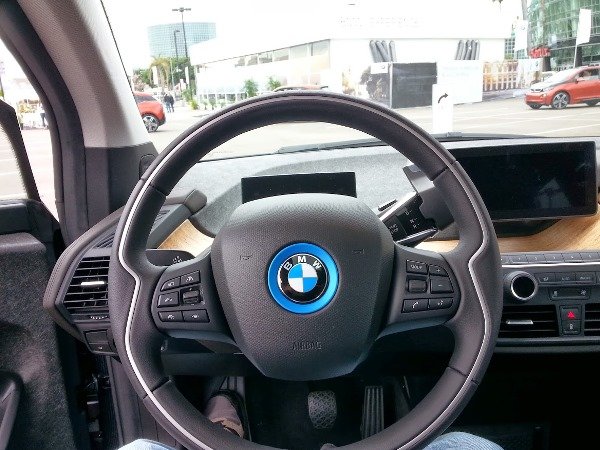


Overall
The BMW i3 just might be the electric car for people that are unsure of electric cars. Electric when you need it (which is to say, most of the time), but with more range when you want it, BMW provides the elegant solution that Chevrolet was reaching for with the Volt. Where the Volt goes forty miles on battery power, then kicks on the too large gasoline engine to provide power, the i3 will double that electric range (or more) and if needed use a highly efficient two-cylinder to charge the battery should you wish to drive farther. The question is, how many are willing to spend $46,125 (including destination) for a four passenger electric vehicle, even if it can be driven all day. The key factor here is that the REX totally eliminates range anxiety. More importantly, it does this without doubling the battery pack size, weight and cost. For new EV owners this could provide the tipping point. Without the REX the BMW i3 comes in at $42,275. Without the REX, the i3 weighs 2,635 pounds. With the REX BMW says it weighs 2,899 pounds. That’s still less than the Spark EV. Available now in Germany, that launch will give us our first answer as to the i3’s public acceptance. Next year i3 will launch in the United States, Japan, China, and Korea.
